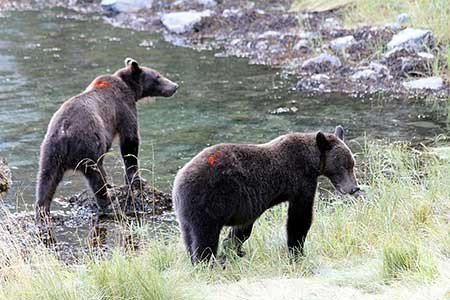Swarms of hungry brown bears are besieging Alaska’s Port Armstrong fish hatchery, refusing to be denied and forcing hatchery workers to engage in high tech combat.
Fish and Wildlife biologists with the Alaska Department of Fish and Game have tried Taser and paintball guns, lasers, rubber bullets, pepper spray, seal bombs, cracker shells, and even a giant potato cannon. Still, the bears keep coming.
Brown bears – Ursula Arctos — are formidable foes. They can hit 40 miles an hour in 16 feet from a dead stop, outrun a quarter horse in a 100-yard dash, and can smell seven times better than a bloodhound.
What’s Your Problem?
Finding yourself between hungry bears and a stream overflowing with tasty salmon is a bad thing – but it happens every day at Port Armstrong.
Located at the tip of Baranoff Island in Southeast Alaska, the hatchery produces more than 100 million salmon annually. As spawning fish crowd the nearby stream, bears invade in droves, far outnumbering the seven permanent hatchery workers. More bears show up each year as cubs raised on a diet of hatchery fish return as adults.
The situation was recently explained in an article for Alaska Fish and Wildlife News. Hatchery staff have tried it all – electric fences, blowing whistles, even resorting to low-tech screaming and yelling.
It may sound extreme – in the lower 48 you can be jailed for hazing wild life – but the alternative is to kill bears under Alaska’s “Defense of Life and Property” rules. The locals go the extra mile and take personal risks to avoid that.
“Don’t Tase Me Bro!”
When warnings don’t work, Tasers have proven the most effective weapon.
More than 325 bears have been “tased” at Port Armstrong, and biologists say so far not one has stood its ground and taken a second hit.
Taser is the brand name for a particularly nasty electrical weapon favored by law enforcement. It fires a pair of small, dart-like probes that connect back to the device by wire. When you’re hit, electrical currents pulse between the two probes, disrupting the body’s voluntary control of muscles and causing what’s known as neuromuscular incapacitation.
“They learn,” said a Fish and Game biologist quoted in an article in Alaska Fish & Wildlife News “We are the aggressors, and they know that. After they’ve been hit once or twice, or seen other bears hit, they’re sensitive.”
“We just don’t want them in the work area, and we want them sensitive enough that they move off when people come out.”
The Biggest Loser
And then there’s the potato cannon. These potato-tossing devices are powered by igniting a charge of hair spray. Tubers in a tube. They can hurl a spud out to 250 yards.
“It would really throw a potato out there,” according to one F&G biologist. “The first time someone nailed a bear, it whacked it pretty good. He jumped, but then when he turned around to come back and see what hit him, and it was a potato, he picked it up and ate it.”
So the spud guns were shelved.
“We didn’t want a situation where bears started lining up waiting to be shot with a potato.”
Going Nocturnal
Faced with superior firepower – potato bazookas aside — the bears then “went nocturnal”, launching daring nighttime raids.
If bears during the day are alarming, bears in the dark are downright scary. “Bears have good eyesight at night and good noses, they don’t need a flashlight”, says Fish and Game.
The answer was FLIR – Forward Looking Infrared – a thermal imaging capability that allows users to see bears at night because they are warmer than their surroundings. Think night vision goggles.
Night tactics also include blue laser lights, basically powerful laser pointers. These are shined at the feet, not in the eyes. For some reason bears really dislike blue lights. On the other hand, they are attracted to green lights (Idea: take a green laser pointer camping with you, and if a bear shows up at night shine it on your buddy’s tent).
Fish and Game also uses commercial devices designed to repel wildlife (primarily from gardens) that combine colored strobe lights with high-pitched noises like people screaming and yelling. These reset in different patterns so animals don’t become used to them. While they are effective, they are not conducive to staff getting good sleep.
And the winner is . . .
The bear are still eating salmon, and the Port Armstrong hatchery is still raising salmon. Call it a draw.
But one must conclude – given the arsenal that the humans have deployed – that bears really, really like salmon and mean to get some.
Alaska river anglers have long been advised that — should they encounter a brown bear while fishing — they should just drop any fish they’ve caught and let the bear have them. Based on the Port Armstrong experience, this would seem to be sound advice.
Photo credit: Alaska Department of Fish and Game








